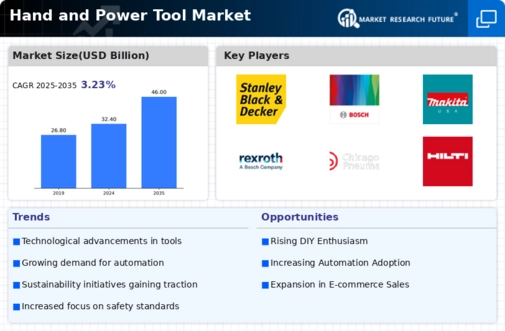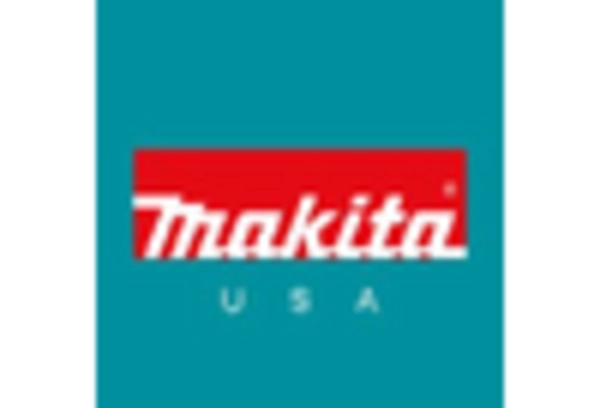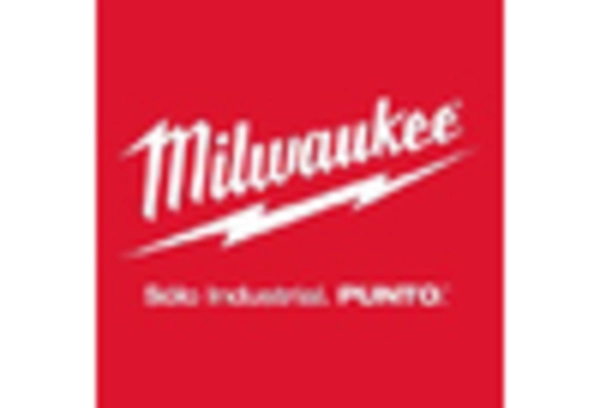E-commerce Expansion
The Hand and Power Tool Market is experiencing a transformative shift due to the rapid expansion of e-commerce platforms. As consumers increasingly prefer online shopping for convenience and variety, the demand for hand and power tools through digital channels is on the rise. In 2025, e-commerce sales in the tools segment are projected to account for over 30 percent of total sales, reflecting a significant change in consumer purchasing behavior. This trend compels manufacturers and retailers to enhance their online presence and optimize their supply chains to meet consumer expectations. Additionally, the availability of detailed product information and customer reviews online aids consumers in making informed decisions. Consequently, the Hand and Power Tool Market is adapting to this e-commerce boom, which is reshaping how tools are marketed and sold.
Increased DIY Culture
The Hand and Power Tool Market is witnessing a notable rise in the do-it-yourself (DIY) culture, which has gained traction among consumers. This trend is driven by a growing interest in home improvement projects, fueled by social media platforms showcasing DIY tutorials and ideas. As of 2025, it is estimated that the DIY home improvement market will reach a valuation of over 400 billion, indicating a robust demand for hand and power tools. Consumers are increasingly investing in tools to undertake their projects, ranging from simple repairs to complex renovations. This shift not only boosts sales for manufacturers but also encourages innovation in tool design, making them more user-friendly and accessible. The Hand and Power Tool Market is thus benefiting from this cultural shift, as more individuals engage in DIY activities.
Sustainability Trends
Sustainability is becoming a pivotal driver in the Hand and Power Tool Market, as consumers and manufacturers alike prioritize eco-friendly practices. There is a growing demand for tools made from sustainable materials and those that promote energy efficiency. In 2025, it is anticipated that the market for sustainable tools will expand significantly, as more consumers seek products that align with their environmental values. Manufacturers are responding by developing tools that minimize waste and reduce carbon footprints, such as electric tools that replace gas-powered alternatives. This shift not only caters to environmentally conscious consumers but also positions companies favorably in a competitive market. The Hand and Power Tool Market is thus adapting to these sustainability trends, which are likely to shape product offerings and marketing strategies.
Technological Innovations
Technological advancements are significantly shaping the Hand and Power Tool Market, leading to the development of smarter and more efficient tools. Innovations such as cordless technology, battery efficiency improvements, and integrated smart features are becoming increasingly prevalent. In 2025, the market for smart tools is expected to grow by approximately 10 percent, reflecting consumer demand for enhanced functionality and convenience. These innovations not only improve user experience but also increase productivity, making tasks easier and faster to complete. Manufacturers are investing in research and development to create tools that incorporate advanced technologies, such as IoT connectivity and automation. As a result, the Hand and Power Tool Market is evolving rapidly, with a focus on meeting the needs of both professional tradespeople and DIY enthusiasts.
Rising Construction Activities
The Hand and Power Tool Market is experiencing a surge in demand due to increasing construction activities across various sectors. As urbanization accelerates, the need for residential and commercial buildings rises, leading to a higher requirement for tools. In 2025, the construction sector is projected to grow at a compound annual growth rate of approximately 5.5 percent, which directly influences the demand for hand and power tools. This growth is not limited to new constructions; renovations and infrastructure upgrades also contribute significantly. Consequently, manufacturers are focusing on producing innovative tools that enhance efficiency and safety, thereby catering to the evolving needs of the construction industry. The Hand and Power Tool Market is thus poised for substantial growth as these trends continue to unfold.

















Leave a Comment